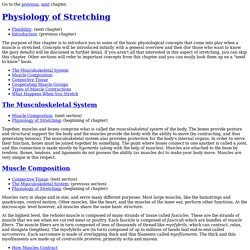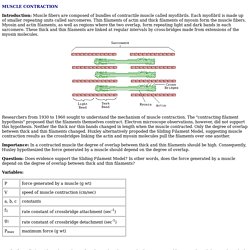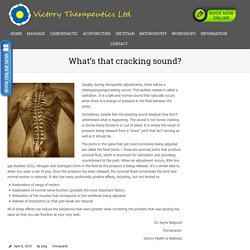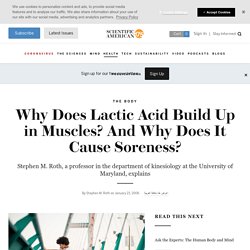

Etiology of Myofascial Trigger Points. Role of myokines in exercise and metabolism. STRETCHING AND FLEXIBILITY - Physiology of Stretching. Go to the previous, next chapter.

Flexibility: (next chapter) Introduction: (previous chapter) The purpose of this chapter is to introduce you to some of the basic physiological concepts that come into play when a muscle is stretched. Concepts will be introduced initially with a general overview and then (for those who want to know the gory details) will be discussed in further detail. If you aren't all that interested in this aspect of stretching, you can skip this chapter. Other sections will refer to important concepts from this chapter and you can easily look them up on a "need to know" basis. The Musculoskeletal System Together, muscles and bones comprise what is called the musculoskeletal system of the body. Joint , and this connection is made mostly by ligaments (along with the help of muscles). Tendons . Muscle Composition Muscles vary in shape and in size, and serve many different purposes.
Proprioception, the True Sixth Sense. STRETCHING AND FLEXIBILITY - Physiology of Stretching. How Resistance Training Shapes Tissues Other Than Your Muscles. (Last Updated On: March 28, 2019) When you pick up a barbell or a pair of dumbbells or resistance bands, your focus turns to building muscle and making the muscles you’re working stronger, but muscles aren’t the only tissues that are transformed by weight training.

Weight training also impacts tissues that support your body and protect it from injury. What are these tissues? Bones and connective tissue, of course. Have you ever thought about how these structural components respond to resistance training? How Weight Training Changes Connective Tissue You depend on healthy connective tissue to protect you from injury when you work out. Tendons are connective tissues that attach muscle to bone.
Healthy tendons are strong and capable of generating a great deal of power. So we know healthy tendons and ligaments are important, but how do these tissues respond to resistance training? Where does the growth take place? Bone Health: How Your Bones Respond to Resistance Training. How Yin Yoga Affects Connective Tissue – Jennifer O'Sullivan. RELAX a Painful Tight Trapezius Muscle in Neck Fast: Exercises, Stretches, Massage & Posture Fixes. Trapezius Myalgia Caused From Forward Head Posture (Best Corrective Exercises) - Dr Mandell, DC. Myokines and Their Importance to Health and Fitness - Fitprince. MUSCLE CONTRACTION. Introduction: Muscle fibers are composed of bundles of contractile muscle called myofibrils.

Each myofibril is made up of smaller repeating units called sarcomeres. Thin filaments of actin and thick filaments of myosin form the muscle fibers. Myosin and actin filaments, as well as regions where the two overlap, form repeating light and dark bands in each sarcomere. These thick and thin filaments are linked at regular intervals by cross-bridges made from extensions of the myosin molecules.
Researchers from 1930 to 1960 sought to understand the mechanism of muscle contraction. Importance: In a contracted muscle the degree of overlap between thick and thin filaments should be high. Question: Does evidence support the Sliding Filament Model? Variables: Methods: Hill (1938) hypothesized specific relationships between the force generated by a muscle and the speed at which a stimulated muscle contracts under a given load.
(P + a)(V+b) = c Hill's relationship can be rewritten as 1. Epstein, H. Why the muscle can’t work properly. Muscles vs fascia. Boundless Anatomy and Physiology. Skeletal Muscle Myokines and Health. Muscle as a paracrine and endocrine organ. Victory Therapeutics Ltd. Usually, during chiropractic adjustments, there will be a clicking/popping/cracking sound.

This audible release is called a cavitation. It is a safe and normal sound that naturally occurs when there is a change of pressure in the fluid between the joints. Sometimes, people fear the popping sound because they don’t understand what is happening. The sound is not bones cracking or bones being forced in or out of place. It is simply the result of pressure being released from a “stuck” joint that isn’t moving as well as it should be. The joints in the spine that are most commonly being adjusted are called the facet joints – these are synovial joints that produce synovial fluid, which is important for lubrication and providing nourishment to the joint.
Restoration of range of motionRestoration of normal nerve function (possibly the most important factor)Relaxation of the muscles that correspond to the vertebrae being adjustedRelease of endorphins so that pain levels are reduced Dr. Chiropractor. Why Does Lactic Acid Build Up in Muscles? And Why Does It Cause Soreness? As our bodies perform strenuous exercise, we begin to breathe faster as we attempt to shuttle more oxygen to our working muscles.

The body prefers to generate most of its energy using aerobic methods, meaning with oxygen. Some circumstances, however—such as evading the historical saber tooth tiger or lifting heavy weights—require energy production faster than our bodies can adequately deliver oxygen. In those cases, the working muscles generate energy anaerobically. This energy comes from glucose through a process called glycolysis, in which glucose is broken down or metabolized into a substance called pyruvate through a series of steps. When the body has plenty of oxygen, pyruvate is shuttled to an aerobic pathway to be further broken down for more energy. A side effect of high lactate levels is an increase in the acidity of the muscle cells, along with disruptions of other metabolites.